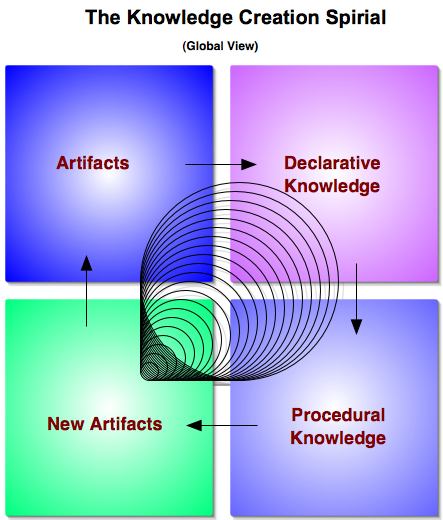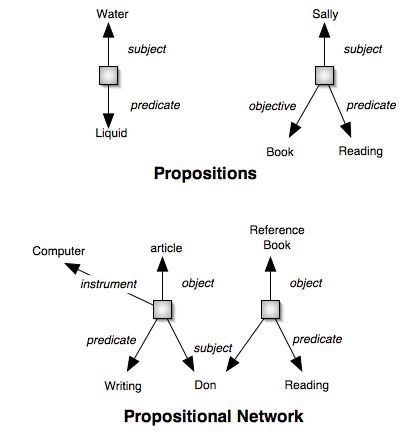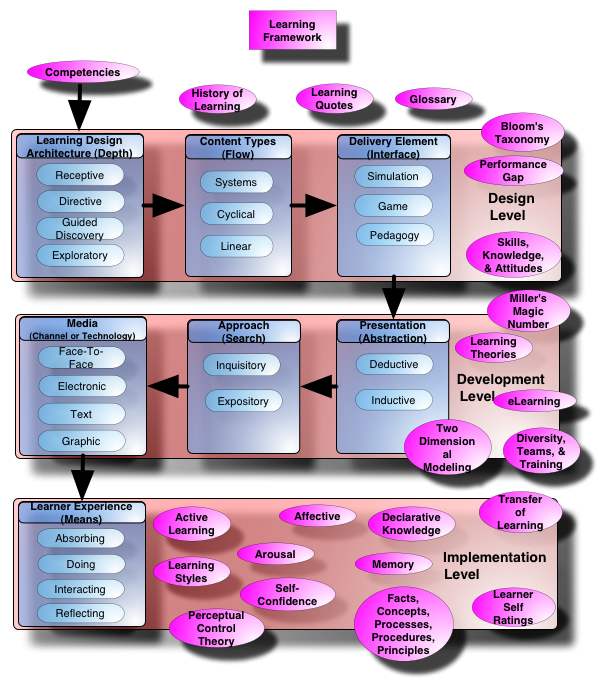Note: This site is moving to KnowledgeJump.com. Please reset your bookmark.
Learning with Artifacts
Knowledge often comes to us via transcribed content or artifacts, which is derived from other's knowledge. These are facts, concepts, processes, procedures, and principles (Clark & Chopeta, 2004). Thus, artifacts are used in the learning process for creating knowledge, while in turn, knowledge creates new artifacts.
Content
There are five primary types of content (artifacts of knowledge): facts, concepts, processes, procedures, and principles (Clark, Mayer, 2007):
Facts
Specific and unique data or instance.
Concepts
A class of items, words, or ideas that are known by a common name, includes multiple specific examples, shares common features. There are two types of concepts: concrete and abstract.
Processes
A flow of events or activities that describe how things work rather than how to do things. There are normally two types: business processes that describe work flows and technical processes that describe how things work in equipment or nature. They can be thought of as the big picture, of how something works.
Procedures
A series of step-by-step actions and decisions that result in the achievement of a task. There are two types of actions: linear and branched.
Principles
Guidelines, rules, and parameters that govern. It includes not only what should be done, but also what should not be done. Principles allow one to make predictions and draw implications. Given an effect, one can infer the cause of a phenomena. Principles are the basic building blocks of causal models or theoretical models (theories).
Knowledge Creation Spirial
Theses artifacts (content) are in turn, used in the knowledge creation process to create two types of knowledge: declarative and procedural, which is shown in the global and detailed views below:


Declarative Knowledge
Declarative models refers to representations of objects and events and how these knowledge and events are related to other objects and events. They focus on the why rather than the how. It allows us to think and talk about the world. Declarative models include propositions and schemata.
Propositions
Declarative knowledge is based on propositions that consist of a predicate or relationship and at least one argument, such as water is liquid or computers are dumb. A predicate can be more detailed, such as Sally is reading a book (Sally is the subject, book is the object, and read is the predicate).
Propositions can, in turn, become propositional networks that contain a number of interrelated facts, such as, "Don is reading a reference book while writing this article on a computer" (Merrienboer, 1997).
Such propositions and propositional networks would look something like this:

Cognitive Schemata
Schemata are higher-level cognitive units that use propositional networks as their building blocks. These are often abstract or general nature that allow us to classify objects or events as belonging to a particular class and to reason about them.
Schemata are composed of conceptional knowledge, plan-like knowledge, and causal knowledge.
Conceptional Knowledge
Concepts are simple schemata that represent a class of objects, events, or other entities by their characteristic features. Concepts enable a person to identify or classify particular instances (concrete object or event) as belonging to a particular class. In a language, most words identify concepts and at least to a certain degree, they are arbitrary in that they can be categorized in many alternative ways.
For example, the concept "car" can be linked to "tires" and "engines." Thus, a instance can be classified as a car or not a car.
Experts possess more powerful concepts in their domain than novices that help them to solve problems. These concepts give them patterns for labeling various memory states, which allow them to classify problems according to their solution mode or deep structure. Where as novices typically classify problems according to their surface structure or superficial feature.
Plan-Like Knowledge (Scripts)
These are simple schemata that describe how goals are related in time or space. They allow us to understand events and organize functions and actions. Plans are often referred to as scripts (or simple procedures) because they represent routine sequences of events.
Causal Knowledge
Causal knowledge are complex schemata that link principles and concepts with each other to form cause-effect relationships. They allow us to interpret events, give explanations, and make predictions.
Procedural Knowledge
Procedural models focus on tasks that must be performed to reach a particular objective or goal. It is characterized as knowing how. Procedural knowledge is often difficult to verbalize and articulate (tacit knowledge) than declarative knowledge.
Procedural knowledge emphasizes hierarchical or information processing approaches based upon productions. A combination of productions create production systems.
Productions
Productions are the building blocks of procedural knowledge and are composed of a condition and an action or IF and THEN statement. For example, IF the light is red, THEN stop (Merrienboer, 1997).
Production Systems
A production system is a set of productions for cognitive processing. It is characterized by the recognize-act cycle in which one production leads to another production. For example:
- IF the light is red, THEN stop
- IF light turns green, THEN release brake
- IF brake is released, THEN step on gas pedal
Thus, in a training environment, knowledge is mainly composed of declarative knowledge, while skills are mainly composed of procedural knowledge. Attitudes are composed of genes and deeply rooted knowledge and skills.
Karl Popper's Three Worlds of Knowledge
Artifacts also relate to Karl Popper's Three Worlds of Knowledge, particularly the third world that consists of artifacts, such as books, tools, theories, models, libraries, computers, and networks.
Reference
Clark, R., Chopeta, L. (2004). Graphics for Learning : Proven Guidelines for Planning, Designing, and Evaluating Visuals in Training Materials . Jossey-Bass/Pfeiffer.
Clark, R. C., Mayer, R. E. (2007). E-Learning and the Science of Instruction. San Francisco: Pfeiffer.
Merrienboer, J. (1997). Training Complex Cognitive Skills: A Four-Component Instructional Design Model for Technical Training. Englewood Cliffs, New Jersey: Educational Technology Publications.


